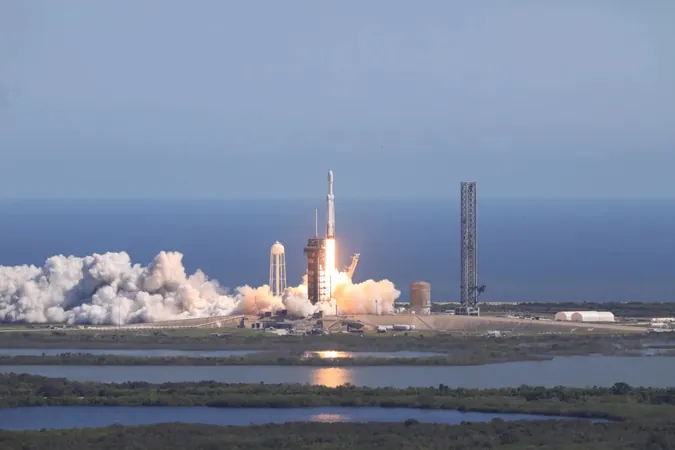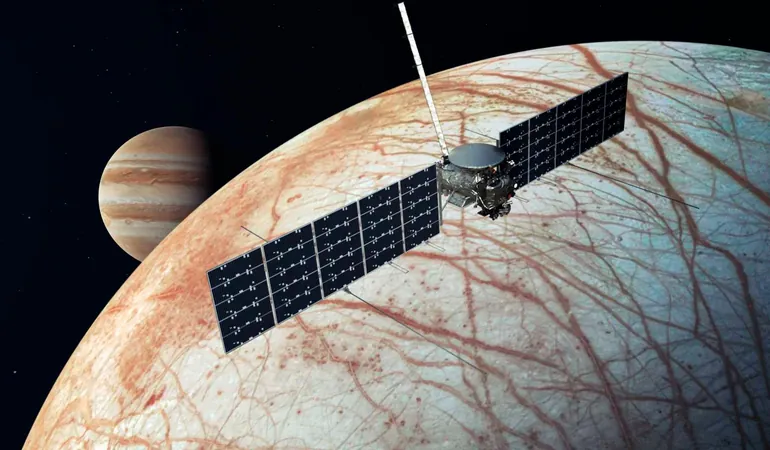
NASA's Europa Clipper Mission: A Groundbreaking Voyage to Jupiter's Mysterious Moon!
2024-10-15
Author: Ming
NASA's Europa Clipper Mission: A Groundbreaking Voyage to Jupiter's Mysterious Moon!
In a monumental leap for space exploration, NASA has successfully launched its Europa Clipper spacecraft, the largest ever constructed for a mission to another planet. Launched atop a SpaceX Falcon Heavy rocket from Kennedy Space Center in Florida, this mission marks a significant milestone in our quest to unravel the mysteries of the cosmos.
Mission controllers at NASA's Jet Propulsion Laboratory confirmed that the Europa Clipper has successfully separated from the rocket's second stage, swiftly unfolding its two solar arrays, which will power the mission throughout its journey. The spacecraft is now embarking on an incredible 1.8 billion-mile odyssey toward Europa, one of Jupiter’s most enigmatic moons, known for its potential to harbor life beneath its icy façade.
Set to arrive in 2031, the Europa Clipper will not take a direct path to Jupiter. Instead, it will execute a series of clever gravity assists, flying by Mars, and in 2026, swinging back by Earth to gain additional speed. This intricate navigation is designed to handle the extensive journey across our solar system.
But why the keen interest in Europa? Underneath its thick icy shell, estimated to be 10 to 15 miles deep, lies a vast ocean, possibly containing twice the volume of water found in all of Earth’s oceans combined. This raises tantalizing questions about the potential for life. As scientist Sandra Connelly, Deputy Associate Administrator in NASA’s Science Mission Directorate eloquently puts it: 'Scientists believe Europa has suitable conditions below its icy surface to support life. Its conditions are water, energy, chemistry, and stability.'
Upon reaching Europa, the Clipper is set to conduct a groundbreaking exploration. It will execute a staggering 49 flybys, coming as close as 16 miles to the surface, allowing for unprecedented observations of the moon's features. Equipped with nine advanced instruments—including ice-penetrating radar, high-definition cameras, and a sophisticated thermal sensor—the Clipper is poised to penetrate through the icy crust to assess the thickness and investigate the depth of the ocean beneath.
Additionally, the spacecraft will closely examine warmer regions of ice and search for plumes of water vapor that may be escaping from the moon's icy mantle. These plumes could provide vital clues about the moon's ocean and its capacity to harbor life.
As humanity stands on the brink of uncovering new frontiers, the Europa Clipper mission represents more than just a scientific expedition—it’s a beacon of hope in understanding our place in the universe and the potential for life beyond Earth. Stay tuned as we follow this groundbreaking mission that could redefine our understanding of life's existence in the cosmos!




 Brasil (PT)
Brasil (PT)
 Canada (EN)
Canada (EN)
 Chile (ES)
Chile (ES)
 España (ES)
España (ES)
 France (FR)
France (FR)
 Hong Kong (EN)
Hong Kong (EN)
 Italia (IT)
Italia (IT)
 日本 (JA)
日本 (JA)
 Magyarország (HU)
Magyarország (HU)
 Norge (NO)
Norge (NO)
 Polska (PL)
Polska (PL)
 Schweiz (DE)
Schweiz (DE)
 Singapore (EN)
Singapore (EN)
 Sverige (SV)
Sverige (SV)
 Suomi (FI)
Suomi (FI)
 Türkiye (TR)
Türkiye (TR)